Related Research Articles

Saab AB, with subsidiaries collectively known as the Saab Group, is a Swedish aerospace and defense company primarily operating from Sweden. The company is headquartered in Stockholm, but its development and manufacturing operations are undertaken in Linköping.

The Saab JAS 39 Gripen is a light single-engine supersonic multirole fighter aircraft manufactured by the Swedish aerospace and defence company Saab AB. The Gripen has a delta wing and canard configuration with relaxed stability design and fly-by-wire flight controls. Later aircraft are fully NATO interoperable. As of 2020, more than 271 Gripens of all models, A–F, have been delivered.

The Saab 37 Viggen is a single-seat, single-engine multirole combat aircraft designed and produced by the Swedish aircraft manufacturer Saab. It was the first canard-equipped aircraft to be produced in quantity and the first to carry an airborne digital central computer with integrated circuits for its avionics, arguably making it the most modern/advanced combat aircraft in Europe at the time of introduction. The digital central computer was the first of its kind in the world, automating and taking over tasks previously requiring a navigator/copilot, facilitating handling in tactical situations where, among other things, high speeds and short decision times determined whether attacks would be successful or not, a system not surpassed until the introduction of the Panavia Tornado into operational service in 1981.
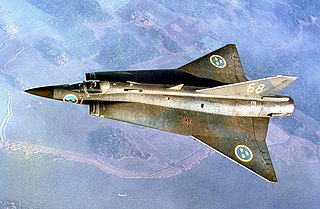
The Saab 35 Draken is a Swedish fighter-interceptor developed and manufactured by Svenska Aeroplan Aktiebolaget (SAAB) between 1955 and 1974. Development of the Saab 35 Draken started in 1948 as the Swedish air force future replacement for the then also in development Saab 29 Tunnan dayfighter and Saab 32B Lansen night fighter. It featured an innovative but unproven double delta wing, which led to the creation of a sub-scale test aircraft, the Saab 210, which was produced and flown to test this previously-unexplored aerodynamic feature. The full-scale production version entered service with frontline squadrons of the Swedish Air Force on 8 March 1960. It was produced in several variants and types, most commonly as a fighter-interceptor.
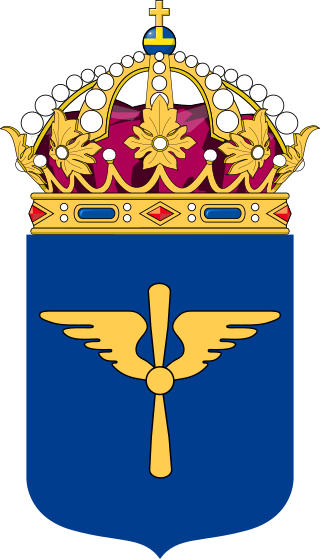
The Swedish Air Force is the air force branch of the Swedish Armed Forces.

The BK 27 is a 27 mm (1.063 in) caliber revolver cannon manufactured by Mauser of Germany. It was developed in the late 1960s for the MRCA program that ultimately became the Panavia Tornado.
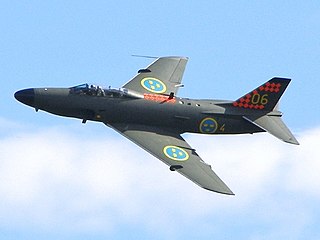
The Saab 32 Lansen is a two-seat, transonic military aircraft designed and manufactured by the Swedish aircraft manufacturer Saab AB.

The Saab 29 Tunnan, colloquially also Flygande Tunnan, is an early jet-powered fighter aircraft designed and produced by the Swedish aircraft manufacturer Saab. It was the second turbojet-powered combat aircraft to be developed in Sweden, the first being the Saab 21R, and it was the first Western European fighter to be produced with a swept wing after the Second World War, only being preceded in Western Europe as a whole by the Messerschmitt Me 262 built during the conflict.

The Saab 105 is a Swedish high-wing, twinjet trainer aircraft developed in the early 1960s as a private venture by Saab AB. The Swedish Air Force, which had opted to procure the type for various roles, issued the aircraft with the designation Sk 60. The Sk 60 entered service in 1967, replacing the ageing De Havilland Vampire fleet.

The Royal Small Arms Factory ADEN cannon is a 30 mm revolver cannon used on many military aircraft, particularly those of the British Royal Air Force and Fleet Air Arm. Developed post-World War II primarily to meet British Air Ministry's requirement for increased lethality in aircraft armament, the cannon was fired electrically and is fully automatic once it is loaded.

The Hughes AIM-4 Falcon was the first operational guided air-to-air missile of the United States Air Force. Development began in 1946; the weapon was first tested in 1949. The missile entered service with the USAF in 1956.
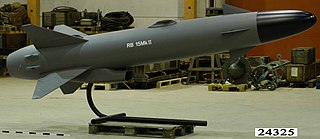
The RBS 15 is a long-range fire-and-forget surface-to-surface and air-to-surface anti-ship missile. The later version Mk. IV has the ability to attack land targets as well. The missile was developed by the Swedish company Saab Bofors Dynamics.

The Saab 18 was a twin-engine bomber and reconnaissance aircraft, designed and built by Svenska Aeroplan AB (SAAB) for use by the Swedish Air Force in response to a 1938 design competition. Due to delays, it did not enter service until 1944, but quickly became the standard Swedish bomber aircraft. Serving in the bomber, reconnaissance and ground-attack roles, it also assisted in the development of ejection seats and air-to-surface guided missiles until its replacement by the Saab Lansen in the late 1950s.
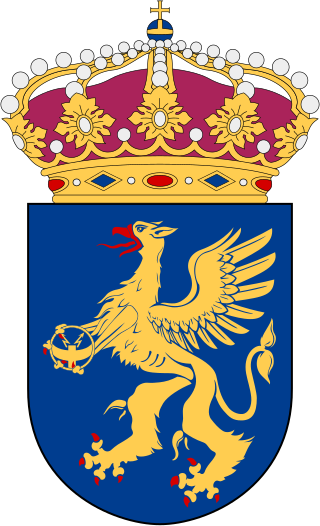
[Swedish] Tactical and Air Defence Control System in forms of STRIL 50 and STRIL 60 were integrated systems for aerial warfare control including early warning radar and ground-controlled interception. The systems depended on radar and radio as primary technologies but STRIL 50 was based on manual control while STRIL 60 applied the usage of early digital computers.

The Saab RB05, initially named Saab 305 or AT 3 internally, was a short-range air-to-surface missile with limited air-to-air capability that was developed in the 1960s by the Swedish company Saab-Scania, Missiles and Electronics for the Swedish Air Force.
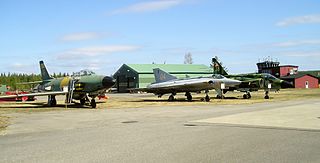
Vidsel Air Base is a Swedish Air Force airfield located 15 km west-northwest of the town of Vidsel, in Sweden. It is a critical part of Vidsel Test Range that provides an aerospace test and evaluation asset for Sweden through the Test & Evaluation (T&E) department of Swedish Defence Materiel Administration (FMV).

Swedish Air Force Historic Flight is an association that flies former Swedish Air Force aircraft and maintains them in an airworthy condition. SwAFHF has been active since 1998 and is housed in premises of the Skaraborg Wing. SwAFHF is authorized by the Swedish Civil Aviation Administration and the aircraft have civilian Swedish aircraft registration.

The Estonian Aviation Museum is located in Lange near Tartu in Estonia. It is the only aviation museum in the country.
The Southern Air Command was an air command within the Swedish Air Force that operated from 1994 to 2000. The unit was based in Ängelholm. It was responsible for air surveillance over South Sweden.
References
- ↑ https://www.forsvarsmakten.se/sv/information-och-fakta/materiel-och-teknik/vapen/jaktrobot-99/
- ↑ "Robot 75". robotmuseum.se. Retrieved 2022-12-27.